PROJ6006: Ecological Wastewater Solutions Case Study Leadership Report
VerifiedAdded on 2022/10/12
|11
|2253
|84
Report
AI Summary
This report analyzes a case study of Ecological Wastewater Solutions (EWS), focusing on leadership styles and project management techniques. The report begins by identifying and justifying the selection of a democratic leadership style for managing the project team, emphasizing its participative nature and effective communication. It then describes various tools and techniques a project manager can utilize to influence the team, including observation, interpersonal skills, and leadership qualities. The report further explores appropriate communication strategies outside the project group, highlighting the benefits of Enterprise Resource Planning (ERP) software. Different types of power in collaborative work are discussed, such as coercive, legitimate, reward, referent, and expert power, and how they motivate team members. The report also outlines methods for developing self-managed teams, including communication, metrics, and accountability. Finally, the report explains the rationale behind the chosen approaches, emphasizing the need to build a competitive business and improve manufacturing techniques, and addresses the steps a project manager should take to face challenges, such as determining issues, analyzing solutions, and implementing strategies. The report concludes with a discussion on feedback mechanisms to improve employee performance and the overall work environment.
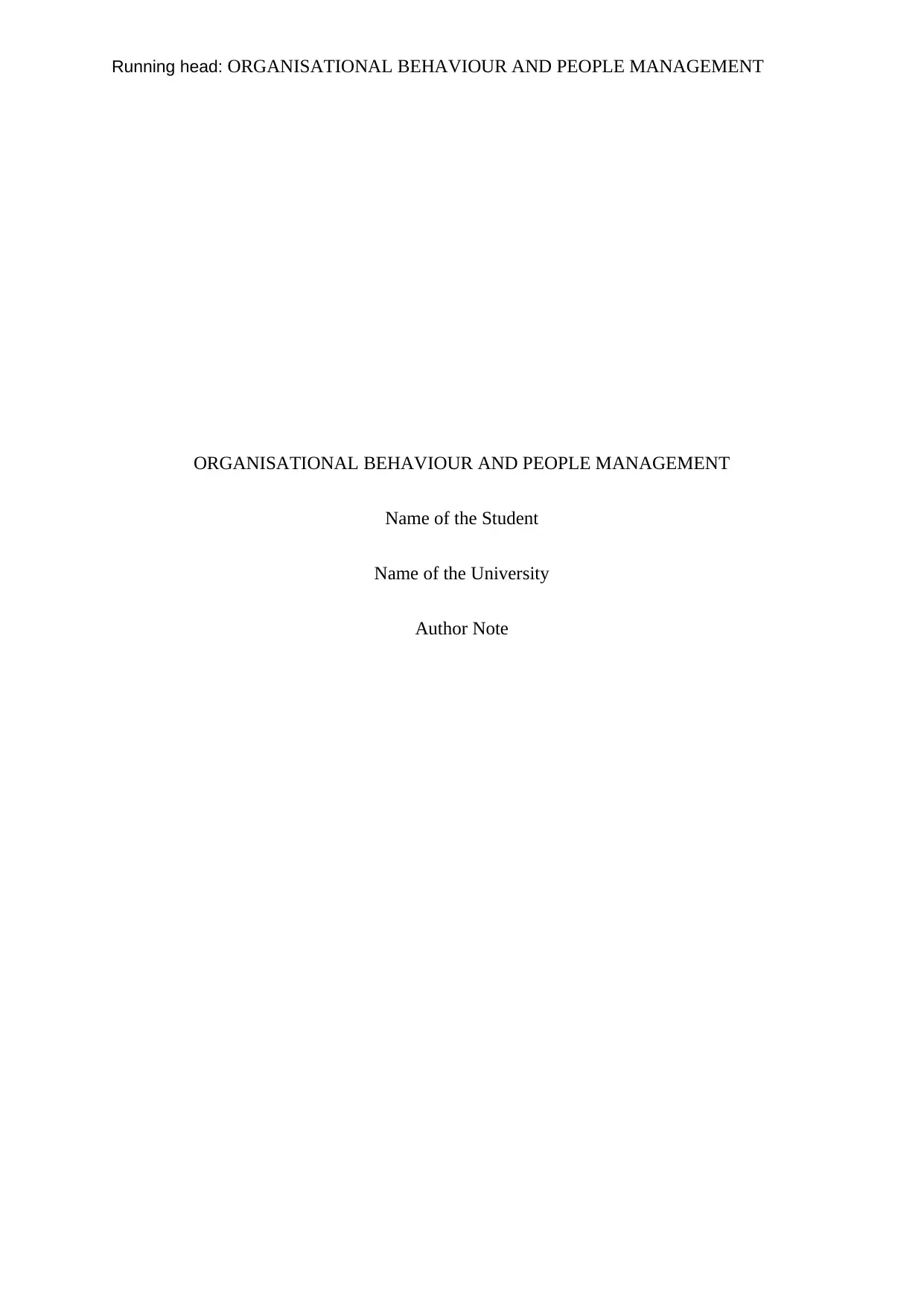
Running head: ORGANISATIONAL BEHAVIOUR AND PEOPLE MANAGEMENT
ORGANISATIONAL BEHAVIOUR AND PEOPLE MANAGEMENT
Name of the Student
Name of the University
Author Note
ORGANISATIONAL BEHAVIOUR AND PEOPLE MANAGEMENT
Name of the Student
Name of the University
Author Note
Paraphrase This Document
Need a fresh take? Get an instant paraphrase of this document with our AI Paraphraser
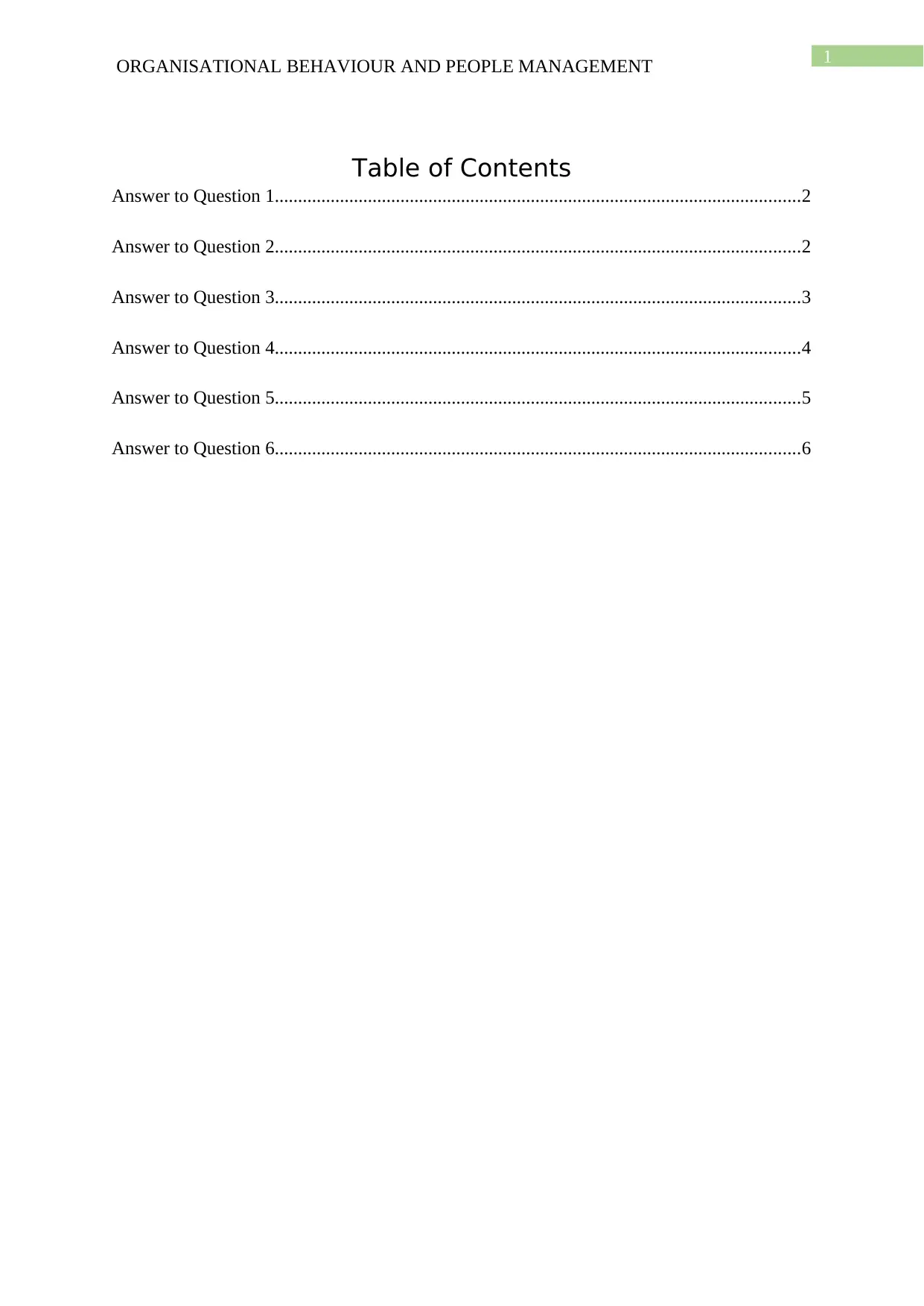
1
ORGANISATIONAL BEHAVIOUR AND PEOPLE MANAGEMENT
Table of Contents
Answer to Question 1.................................................................................................................2
Answer to Question 2.................................................................................................................2
Answer to Question 3.................................................................................................................3
Answer to Question 4.................................................................................................................4
Answer to Question 5.................................................................................................................5
Answer to Question 6.................................................................................................................6
ORGANISATIONAL BEHAVIOUR AND PEOPLE MANAGEMENT
Table of Contents
Answer to Question 1.................................................................................................................2
Answer to Question 2.................................................................................................................2
Answer to Question 3.................................................................................................................3
Answer to Question 4.................................................................................................................4
Answer to Question 5.................................................................................................................5
Answer to Question 6.................................................................................................................6
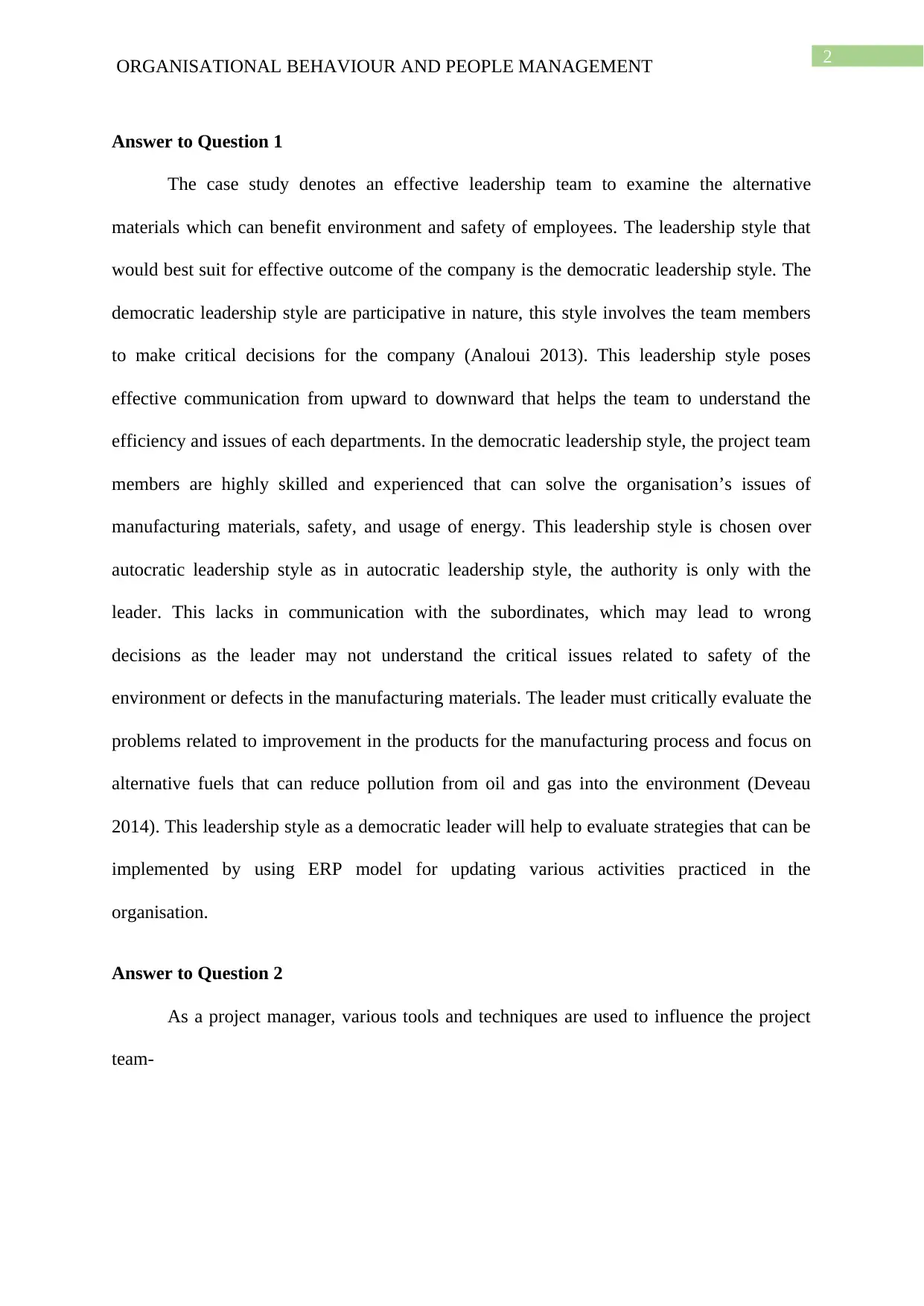
2
ORGANISATIONAL BEHAVIOUR AND PEOPLE MANAGEMENT
Answer to Question 1
The case study denotes an effective leadership team to examine the alternative
materials which can benefit environment and safety of employees. The leadership style that
would best suit for effective outcome of the company is the democratic leadership style. The
democratic leadership style are participative in nature, this style involves the team members
to make critical decisions for the company (Analoui 2013). This leadership style poses
effective communication from upward to downward that helps the team to understand the
efficiency and issues of each departments. In the democratic leadership style, the project team
members are highly skilled and experienced that can solve the organisation’s issues of
manufacturing materials, safety, and usage of energy. This leadership style is chosen over
autocratic leadership style as in autocratic leadership style, the authority is only with the
leader. This lacks in communication with the subordinates, which may lead to wrong
decisions as the leader may not understand the critical issues related to safety of the
environment or defects in the manufacturing materials. The leader must critically evaluate the
problems related to improvement in the products for the manufacturing process and focus on
alternative fuels that can reduce pollution from oil and gas into the environment (Deveau
2014). This leadership style as a democratic leader will help to evaluate strategies that can be
implemented by using ERP model for updating various activities practiced in the
organisation.
Answer to Question 2
As a project manager, various tools and techniques are used to influence the project
team-
ORGANISATIONAL BEHAVIOUR AND PEOPLE MANAGEMENT
Answer to Question 1
The case study denotes an effective leadership team to examine the alternative
materials which can benefit environment and safety of employees. The leadership style that
would best suit for effective outcome of the company is the democratic leadership style. The
democratic leadership style are participative in nature, this style involves the team members
to make critical decisions for the company (Analoui 2013). This leadership style poses
effective communication from upward to downward that helps the team to understand the
efficiency and issues of each departments. In the democratic leadership style, the project team
members are highly skilled and experienced that can solve the organisation’s issues of
manufacturing materials, safety, and usage of energy. This leadership style is chosen over
autocratic leadership style as in autocratic leadership style, the authority is only with the
leader. This lacks in communication with the subordinates, which may lead to wrong
decisions as the leader may not understand the critical issues related to safety of the
environment or defects in the manufacturing materials. The leader must critically evaluate the
problems related to improvement in the products for the manufacturing process and focus on
alternative fuels that can reduce pollution from oil and gas into the environment (Deveau
2014). This leadership style as a democratic leader will help to evaluate strategies that can be
implemented by using ERP model for updating various activities practiced in the
organisation.
Answer to Question 2
As a project manager, various tools and techniques are used to influence the project
team-
⊘ This is a preview!⊘
Do you want full access?
Subscribe today to unlock all pages.

Trusted by 1+ million students worldwide
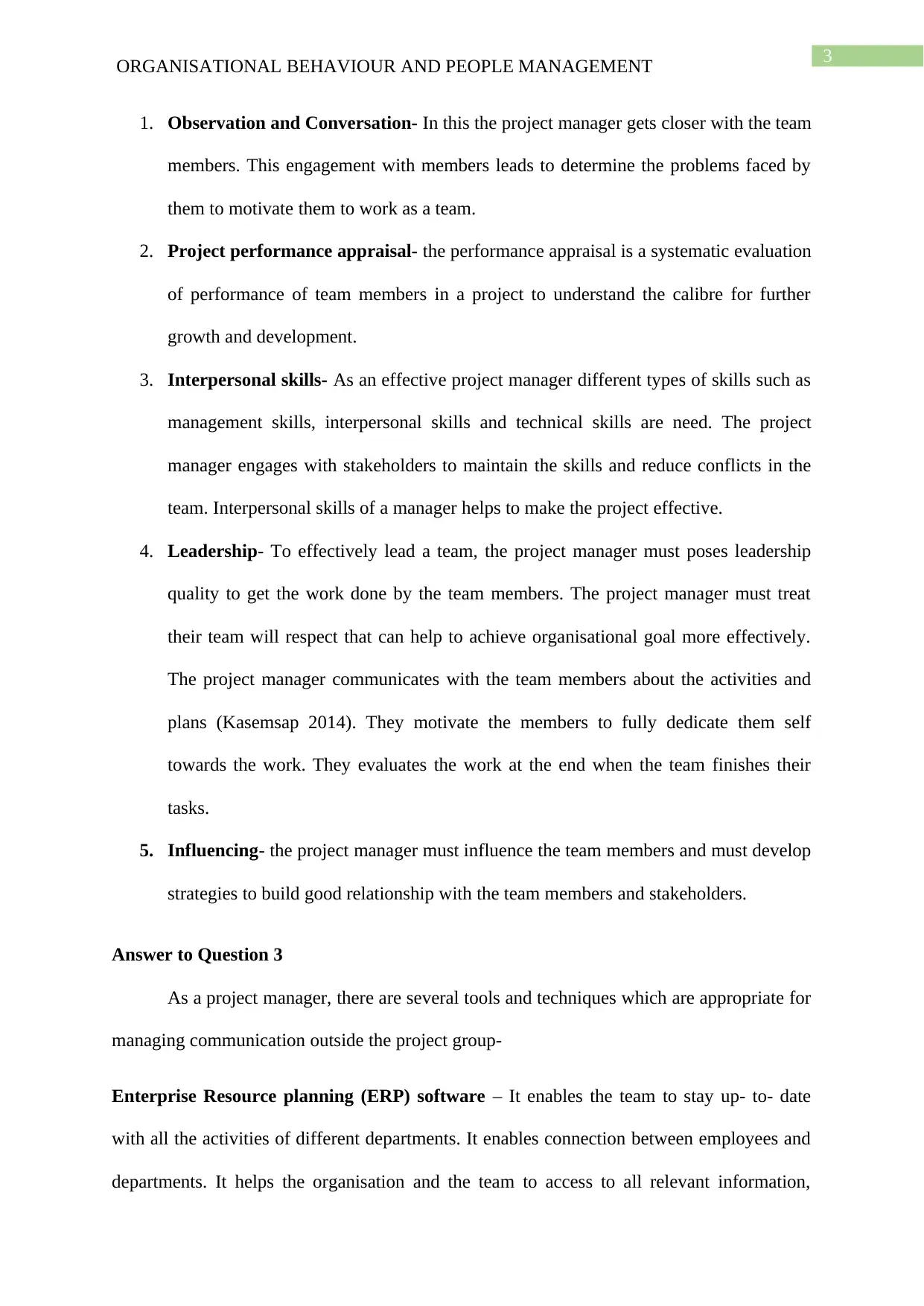
3
ORGANISATIONAL BEHAVIOUR AND PEOPLE MANAGEMENT
1. Observation and Conversation- In this the project manager gets closer with the team
members. This engagement with members leads to determine the problems faced by
them to motivate them to work as a team.
2. Project performance appraisal- the performance appraisal is a systematic evaluation
of performance of team members in a project to understand the calibre for further
growth and development.
3. Interpersonal skills- As an effective project manager different types of skills such as
management skills, interpersonal skills and technical skills are need. The project
manager engages with stakeholders to maintain the skills and reduce conflicts in the
team. Interpersonal skills of a manager helps to make the project effective.
4. Leadership- To effectively lead a team, the project manager must poses leadership
quality to get the work done by the team members. The project manager must treat
their team will respect that can help to achieve organisational goal more effectively.
The project manager communicates with the team members about the activities and
plans (Kasemsap 2014). They motivate the members to fully dedicate them self
towards the work. They evaluates the work at the end when the team finishes their
tasks.
5. Influencing- the project manager must influence the team members and must develop
strategies to build good relationship with the team members and stakeholders.
Answer to Question 3
As a project manager, there are several tools and techniques which are appropriate for
managing communication outside the project group-
Enterprise Resource planning (ERP) software – It enables the team to stay up- to- date
with all the activities of different departments. It enables connection between employees and
departments. It helps the organisation and the team to access to all relevant information,
ORGANISATIONAL BEHAVIOUR AND PEOPLE MANAGEMENT
1. Observation and Conversation- In this the project manager gets closer with the team
members. This engagement with members leads to determine the problems faced by
them to motivate them to work as a team.
2. Project performance appraisal- the performance appraisal is a systematic evaluation
of performance of team members in a project to understand the calibre for further
growth and development.
3. Interpersonal skills- As an effective project manager different types of skills such as
management skills, interpersonal skills and technical skills are need. The project
manager engages with stakeholders to maintain the skills and reduce conflicts in the
team. Interpersonal skills of a manager helps to make the project effective.
4. Leadership- To effectively lead a team, the project manager must poses leadership
quality to get the work done by the team members. The project manager must treat
their team will respect that can help to achieve organisational goal more effectively.
The project manager communicates with the team members about the activities and
plans (Kasemsap 2014). They motivate the members to fully dedicate them self
towards the work. They evaluates the work at the end when the team finishes their
tasks.
5. Influencing- the project manager must influence the team members and must develop
strategies to build good relationship with the team members and stakeholders.
Answer to Question 3
As a project manager, there are several tools and techniques which are appropriate for
managing communication outside the project group-
Enterprise Resource planning (ERP) software – It enables the team to stay up- to- date
with all the activities of different departments. It enables connection between employees and
departments. It helps the organisation and the team to access to all relevant information,
Paraphrase This Document
Need a fresh take? Get an instant paraphrase of this document with our AI Paraphraser
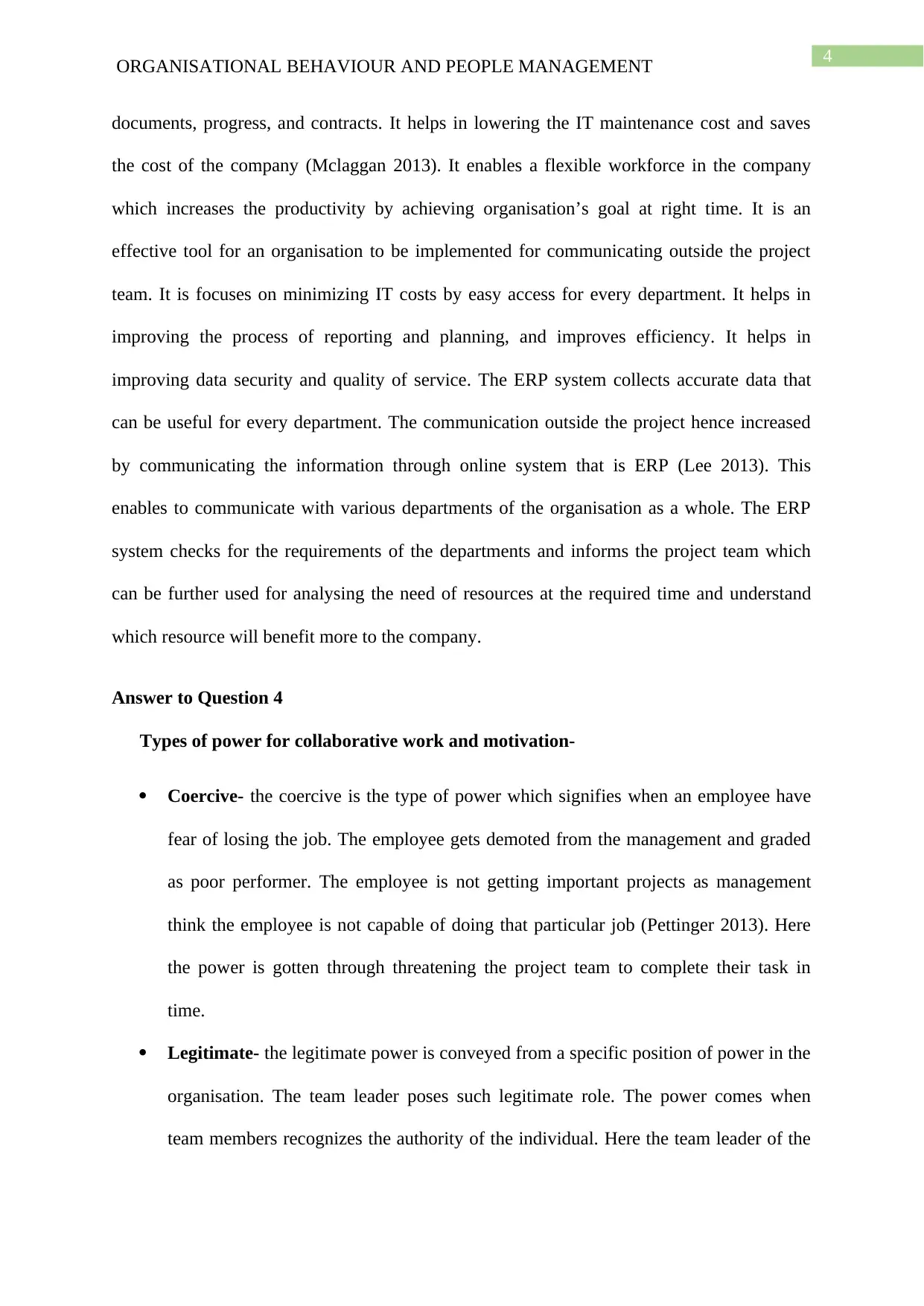
4
ORGANISATIONAL BEHAVIOUR AND PEOPLE MANAGEMENT
documents, progress, and contracts. It helps in lowering the IT maintenance cost and saves
the cost of the company (Mclaggan 2013). It enables a flexible workforce in the company
which increases the productivity by achieving organisation’s goal at right time. It is an
effective tool for an organisation to be implemented for communicating outside the project
team. It is focuses on minimizing IT costs by easy access for every department. It helps in
improving the process of reporting and planning, and improves efficiency. It helps in
improving data security and quality of service. The ERP system collects accurate data that
can be useful for every department. The communication outside the project hence increased
by communicating the information through online system that is ERP (Lee 2013). This
enables to communicate with various departments of the organisation as a whole. The ERP
system checks for the requirements of the departments and informs the project team which
can be further used for analysing the need of resources at the required time and understand
which resource will benefit more to the company.
Answer to Question 4
Types of power for collaborative work and motivation-
Coercive- the coercive is the type of power which signifies when an employee have
fear of losing the job. The employee gets demoted from the management and graded
as poor performer. The employee is not getting important projects as management
think the employee is not capable of doing that particular job (Pettinger 2013). Here
the power is gotten through threatening the project team to complete their task in
time.
Legitimate- the legitimate power is conveyed from a specific position of power in the
organisation. The team leader poses such legitimate role. The power comes when
team members recognizes the authority of the individual. Here the team leader of the
ORGANISATIONAL BEHAVIOUR AND PEOPLE MANAGEMENT
documents, progress, and contracts. It helps in lowering the IT maintenance cost and saves
the cost of the company (Mclaggan 2013). It enables a flexible workforce in the company
which increases the productivity by achieving organisation’s goal at right time. It is an
effective tool for an organisation to be implemented for communicating outside the project
team. It is focuses on minimizing IT costs by easy access for every department. It helps in
improving the process of reporting and planning, and improves efficiency. It helps in
improving data security and quality of service. The ERP system collects accurate data that
can be useful for every department. The communication outside the project hence increased
by communicating the information through online system that is ERP (Lee 2013). This
enables to communicate with various departments of the organisation as a whole. The ERP
system checks for the requirements of the departments and informs the project team which
can be further used for analysing the need of resources at the required time and understand
which resource will benefit more to the company.
Answer to Question 4
Types of power for collaborative work and motivation-
Coercive- the coercive is the type of power which signifies when an employee have
fear of losing the job. The employee gets demoted from the management and graded
as poor performer. The employee is not getting important projects as management
think the employee is not capable of doing that particular job (Pettinger 2013). Here
the power is gotten through threatening the project team to complete their task in
time.
Legitimate- the legitimate power is conveyed from a specific position of power in the
organisation. The team leader poses such legitimate role. The power comes when
team members recognizes the authority of the individual. Here the team leader of the
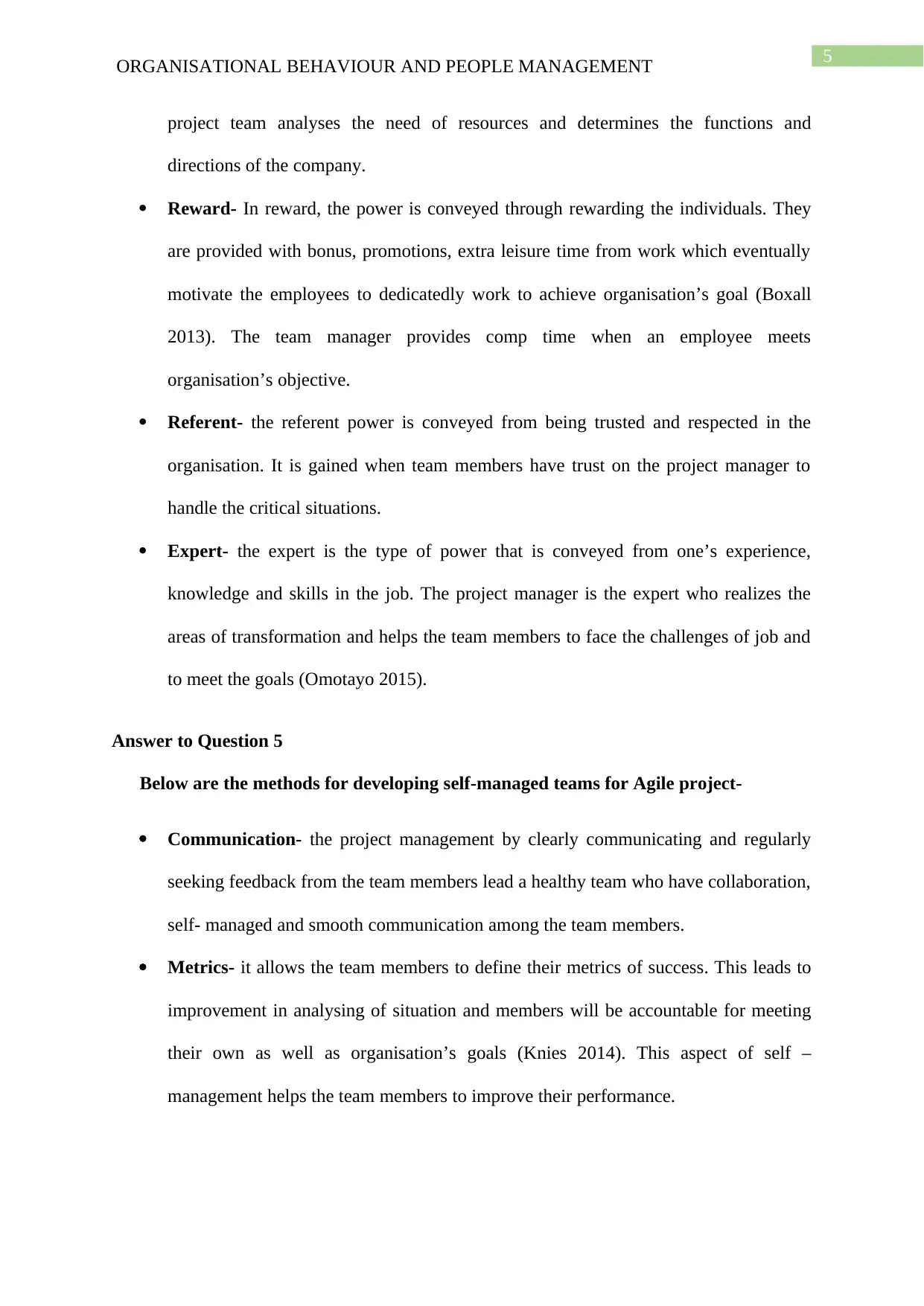
5
ORGANISATIONAL BEHAVIOUR AND PEOPLE MANAGEMENT
project team analyses the need of resources and determines the functions and
directions of the company.
Reward- In reward, the power is conveyed through rewarding the individuals. They
are provided with bonus, promotions, extra leisure time from work which eventually
motivate the employees to dedicatedly work to achieve organisation’s goal (Boxall
2013). The team manager provides comp time when an employee meets
organisation’s objective.
Referent- the referent power is conveyed from being trusted and respected in the
organisation. It is gained when team members have trust on the project manager to
handle the critical situations.
Expert- the expert is the type of power that is conveyed from one’s experience,
knowledge and skills in the job. The project manager is the expert who realizes the
areas of transformation and helps the team members to face the challenges of job and
to meet the goals (Omotayo 2015).
Answer to Question 5
Below are the methods for developing self-managed teams for Agile project-
Communication- the project management by clearly communicating and regularly
seeking feedback from the team members lead a healthy team who have collaboration,
self- managed and smooth communication among the team members.
Metrics- it allows the team members to define their metrics of success. This leads to
improvement in analysing of situation and members will be accountable for meeting
their own as well as organisation’s goals (Knies 2014). This aspect of self –
management helps the team members to improve their performance.
ORGANISATIONAL BEHAVIOUR AND PEOPLE MANAGEMENT
project team analyses the need of resources and determines the functions and
directions of the company.
Reward- In reward, the power is conveyed through rewarding the individuals. They
are provided with bonus, promotions, extra leisure time from work which eventually
motivate the employees to dedicatedly work to achieve organisation’s goal (Boxall
2013). The team manager provides comp time when an employee meets
organisation’s objective.
Referent- the referent power is conveyed from being trusted and respected in the
organisation. It is gained when team members have trust on the project manager to
handle the critical situations.
Expert- the expert is the type of power that is conveyed from one’s experience,
knowledge and skills in the job. The project manager is the expert who realizes the
areas of transformation and helps the team members to face the challenges of job and
to meet the goals (Omotayo 2015).
Answer to Question 5
Below are the methods for developing self-managed teams for Agile project-
Communication- the project management by clearly communicating and regularly
seeking feedback from the team members lead a healthy team who have collaboration,
self- managed and smooth communication among the team members.
Metrics- it allows the team members to define their metrics of success. This leads to
improvement in analysing of situation and members will be accountable for meeting
their own as well as organisation’s goals (Knies 2014). This aspect of self –
management helps the team members to improve their performance.
⊘ This is a preview!⊘
Do you want full access?
Subscribe today to unlock all pages.

Trusted by 1+ million students worldwide
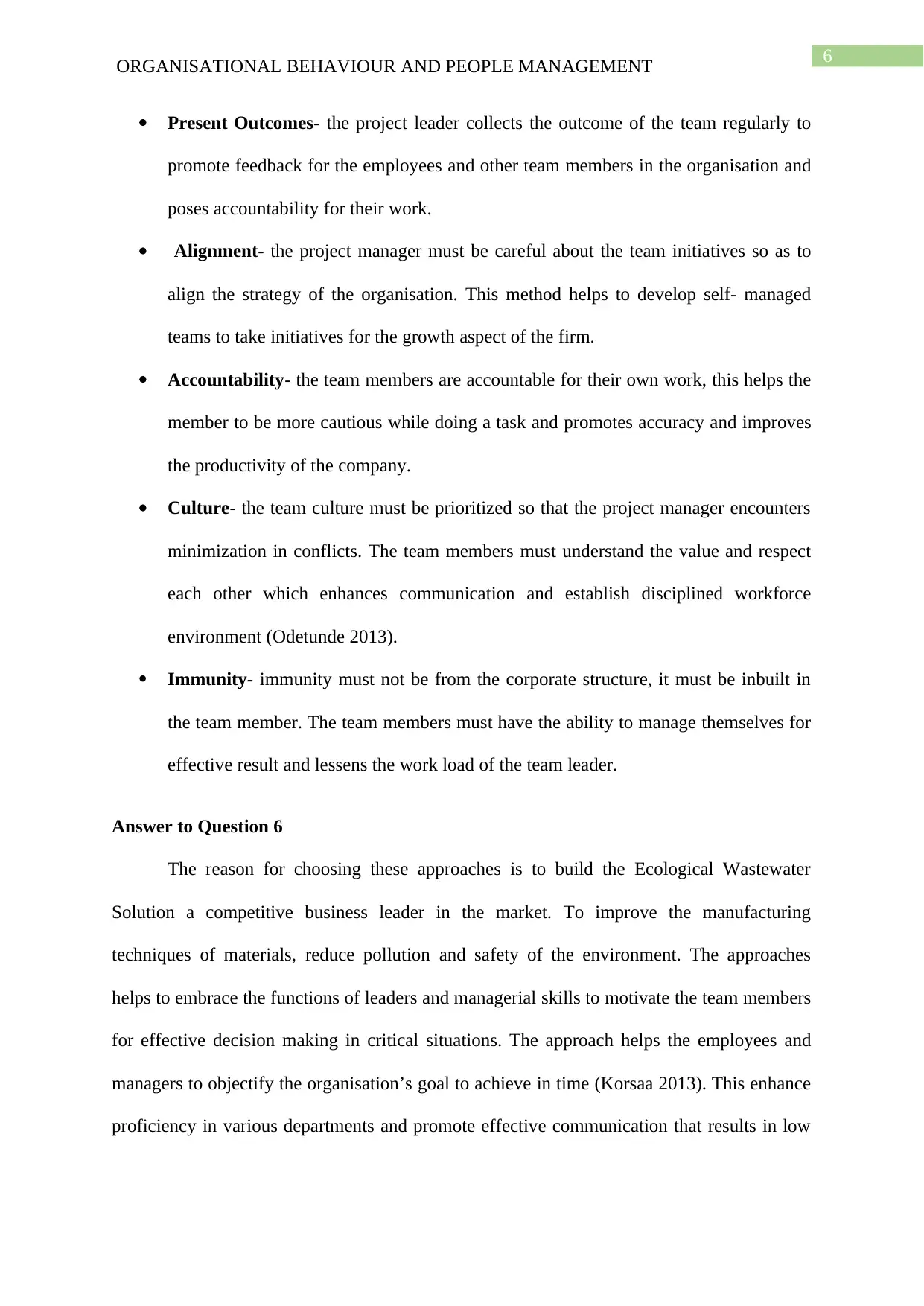
6
ORGANISATIONAL BEHAVIOUR AND PEOPLE MANAGEMENT
Present Outcomes- the project leader collects the outcome of the team regularly to
promote feedback for the employees and other team members in the organisation and
poses accountability for their work.
Alignment- the project manager must be careful about the team initiatives so as to
align the strategy of the organisation. This method helps to develop self- managed
teams to take initiatives for the growth aspect of the firm.
Accountability- the team members are accountable for their own work, this helps the
member to be more cautious while doing a task and promotes accuracy and improves
the productivity of the company.
Culture- the team culture must be prioritized so that the project manager encounters
minimization in conflicts. The team members must understand the value and respect
each other which enhances communication and establish disciplined workforce
environment (Odetunde 2013).
Immunity- immunity must not be from the corporate structure, it must be inbuilt in
the team member. The team members must have the ability to manage themselves for
effective result and lessens the work load of the team leader.
Answer to Question 6
The reason for choosing these approaches is to build the Ecological Wastewater
Solution a competitive business leader in the market. To improve the manufacturing
techniques of materials, reduce pollution and safety of the environment. The approaches
helps to embrace the functions of leaders and managerial skills to motivate the team members
for effective decision making in critical situations. The approach helps the employees and
managers to objectify the organisation’s goal to achieve in time (Korsaa 2013). This enhance
proficiency in various departments and promote effective communication that results in low
ORGANISATIONAL BEHAVIOUR AND PEOPLE MANAGEMENT
Present Outcomes- the project leader collects the outcome of the team regularly to
promote feedback for the employees and other team members in the organisation and
poses accountability for their work.
Alignment- the project manager must be careful about the team initiatives so as to
align the strategy of the organisation. This method helps to develop self- managed
teams to take initiatives for the growth aspect of the firm.
Accountability- the team members are accountable for their own work, this helps the
member to be more cautious while doing a task and promotes accuracy and improves
the productivity of the company.
Culture- the team culture must be prioritized so that the project manager encounters
minimization in conflicts. The team members must understand the value and respect
each other which enhances communication and establish disciplined workforce
environment (Odetunde 2013).
Immunity- immunity must not be from the corporate structure, it must be inbuilt in
the team member. The team members must have the ability to manage themselves for
effective result and lessens the work load of the team leader.
Answer to Question 6
The reason for choosing these approaches is to build the Ecological Wastewater
Solution a competitive business leader in the market. To improve the manufacturing
techniques of materials, reduce pollution and safety of the environment. The approaches
helps to embrace the functions of leaders and managerial skills to motivate the team members
for effective decision making in critical situations. The approach helps the employees and
managers to objectify the organisation’s goal to achieve in time (Korsaa 2013). This enhance
proficiency in various departments and promote effective communication that results in low
Paraphrase This Document
Need a fresh take? Get an instant paraphrase of this document with our AI Paraphraser
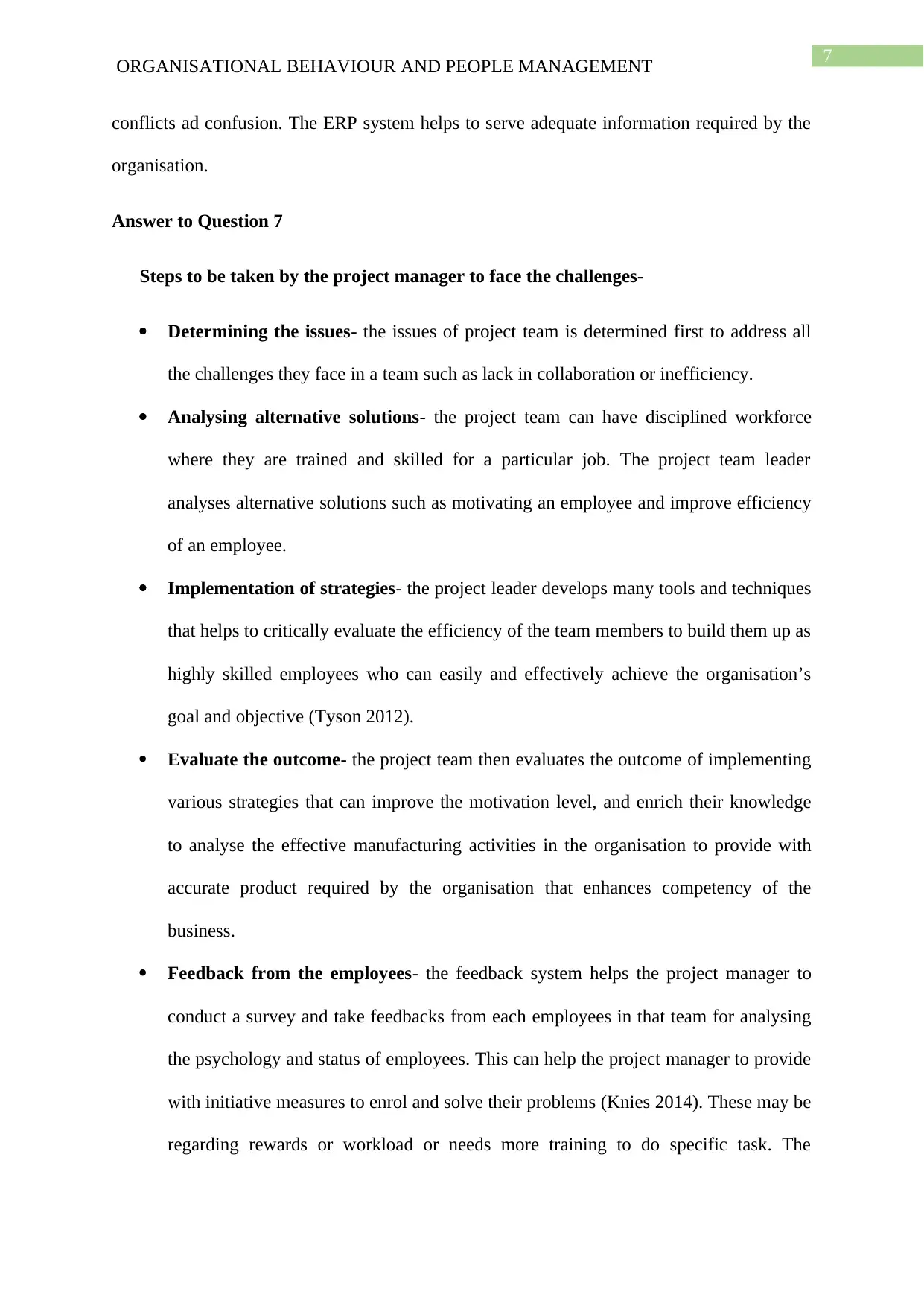
7
ORGANISATIONAL BEHAVIOUR AND PEOPLE MANAGEMENT
conflicts ad confusion. The ERP system helps to serve adequate information required by the
organisation.
Answer to Question 7
Steps to be taken by the project manager to face the challenges-
Determining the issues- the issues of project team is determined first to address all
the challenges they face in a team such as lack in collaboration or inefficiency.
Analysing alternative solutions- the project team can have disciplined workforce
where they are trained and skilled for a particular job. The project team leader
analyses alternative solutions such as motivating an employee and improve efficiency
of an employee.
Implementation of strategies- the project leader develops many tools and techniques
that helps to critically evaluate the efficiency of the team members to build them up as
highly skilled employees who can easily and effectively achieve the organisation’s
goal and objective (Tyson 2012).
Evaluate the outcome- the project team then evaluates the outcome of implementing
various strategies that can improve the motivation level, and enrich their knowledge
to analyse the effective manufacturing activities in the organisation to provide with
accurate product required by the organisation that enhances competency of the
business.
Feedback from the employees- the feedback system helps the project manager to
conduct a survey and take feedbacks from each employees in that team for analysing
the psychology and status of employees. This can help the project manager to provide
with initiative measures to enrol and solve their problems (Knies 2014). These may be
regarding rewards or workload or needs more training to do specific task. The
ORGANISATIONAL BEHAVIOUR AND PEOPLE MANAGEMENT
conflicts ad confusion. The ERP system helps to serve adequate information required by the
organisation.
Answer to Question 7
Steps to be taken by the project manager to face the challenges-
Determining the issues- the issues of project team is determined first to address all
the challenges they face in a team such as lack in collaboration or inefficiency.
Analysing alternative solutions- the project team can have disciplined workforce
where they are trained and skilled for a particular job. The project team leader
analyses alternative solutions such as motivating an employee and improve efficiency
of an employee.
Implementation of strategies- the project leader develops many tools and techniques
that helps to critically evaluate the efficiency of the team members to build them up as
highly skilled employees who can easily and effectively achieve the organisation’s
goal and objective (Tyson 2012).
Evaluate the outcome- the project team then evaluates the outcome of implementing
various strategies that can improve the motivation level, and enrich their knowledge
to analyse the effective manufacturing activities in the organisation to provide with
accurate product required by the organisation that enhances competency of the
business.
Feedback from the employees- the feedback system helps the project manager to
conduct a survey and take feedbacks from each employees in that team for analysing
the psychology and status of employees. This can help the project manager to provide
with initiative measures to enrol and solve their problems (Knies 2014). These may be
regarding rewards or workload or needs more training to do specific task. The
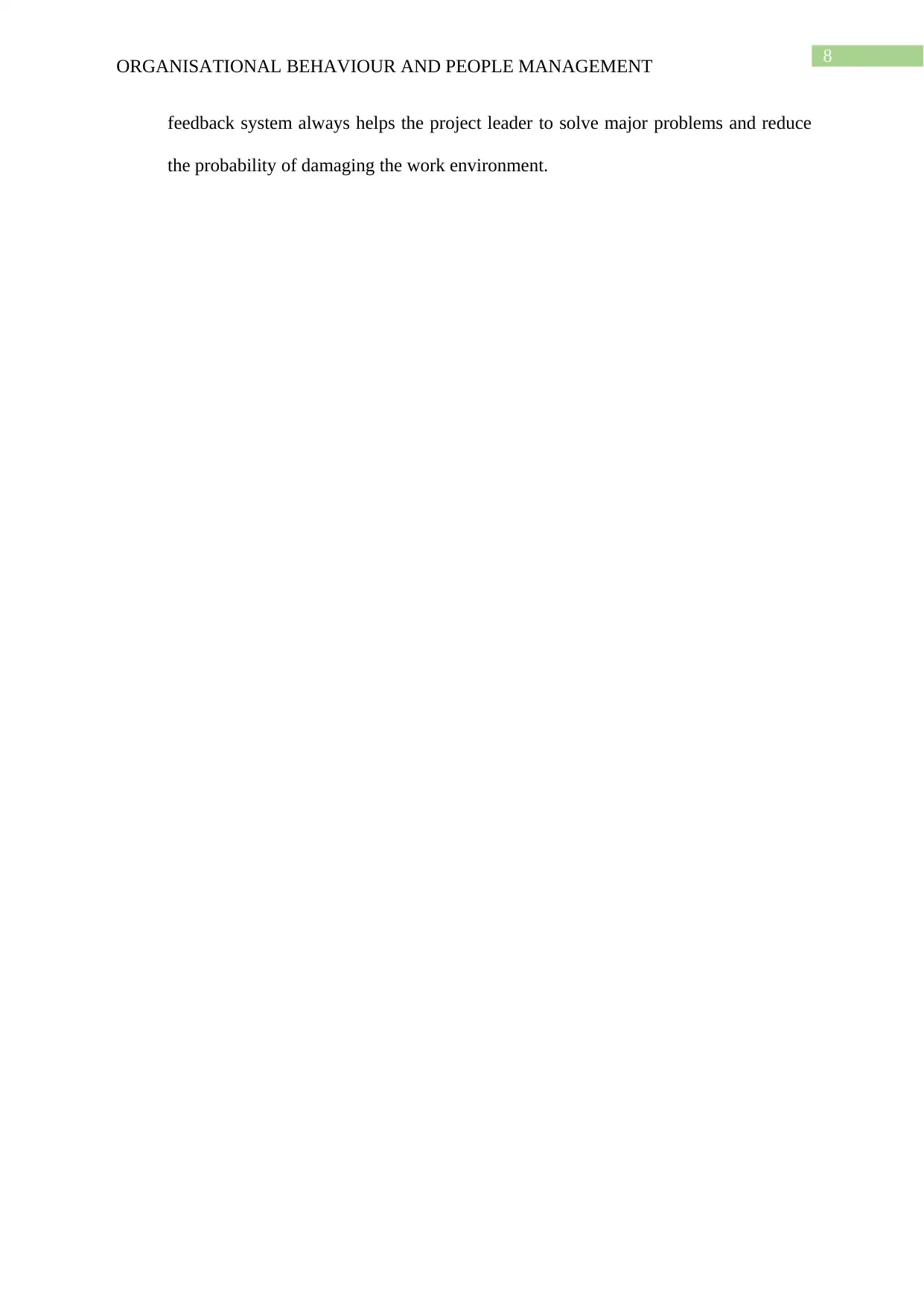
8
ORGANISATIONAL BEHAVIOUR AND PEOPLE MANAGEMENT
feedback system always helps the project leader to solve major problems and reduce
the probability of damaging the work environment.
ORGANISATIONAL BEHAVIOUR AND PEOPLE MANAGEMENT
feedback system always helps the project leader to solve major problems and reduce
the probability of damaging the work environment.
⊘ This is a preview!⊘
Do you want full access?
Subscribe today to unlock all pages.

Trusted by 1+ million students worldwide
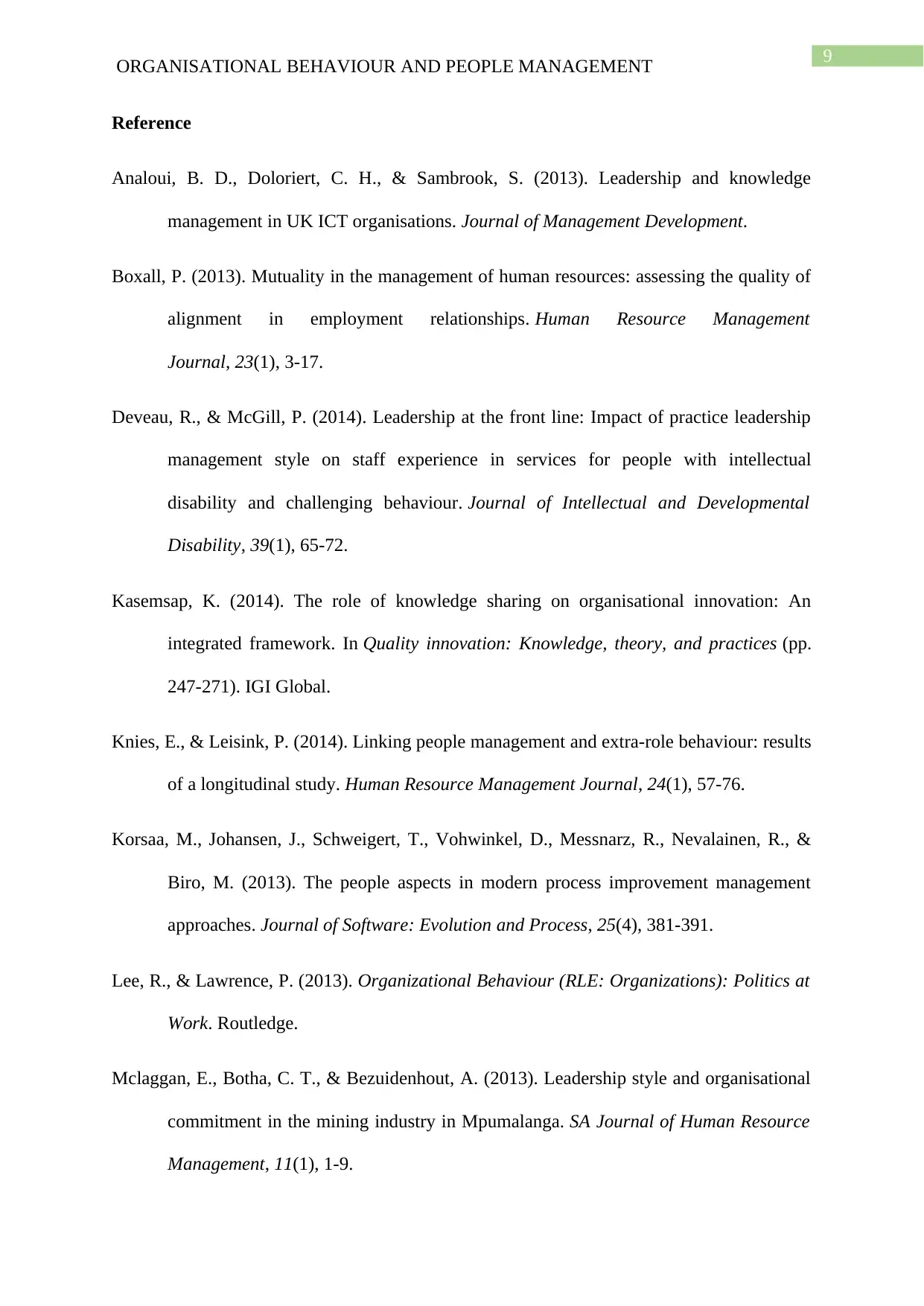
9
ORGANISATIONAL BEHAVIOUR AND PEOPLE MANAGEMENT
Reference
Analoui, B. D., Doloriert, C. H., & Sambrook, S. (2013). Leadership and knowledge
management in UK ICT organisations. Journal of Management Development.
Boxall, P. (2013). Mutuality in the management of human resources: assessing the quality of
alignment in employment relationships. Human Resource Management
Journal, 23(1), 3-17.
Deveau, R., & McGill, P. (2014). Leadership at the front line: Impact of practice leadership
management style on staff experience in services for people with intellectual
disability and challenging behaviour. Journal of Intellectual and Developmental
Disability, 39(1), 65-72.
Kasemsap, K. (2014). The role of knowledge sharing on organisational innovation: An
integrated framework. In Quality innovation: Knowledge, theory, and practices (pp.
247-271). IGI Global.
Knies, E., & Leisink, P. (2014). Linking people management and extra‐role behaviour: results
of a longitudinal study. Human Resource Management Journal, 24(1), 57-76.
Korsaa, M., Johansen, J., Schweigert, T., Vohwinkel, D., Messnarz, R., Nevalainen, R., &
Biro, M. (2013). The people aspects in modern process improvement management
approaches. Journal of Software: Evolution and Process, 25(4), 381-391.
Lee, R., & Lawrence, P. (2013). Organizational Behaviour (RLE: Organizations): Politics at
Work. Routledge.
Mclaggan, E., Botha, C. T., & Bezuidenhout, A. (2013). Leadership style and organisational
commitment in the mining industry in Mpumalanga. SA Journal of Human Resource
Management, 11(1), 1-9.
ORGANISATIONAL BEHAVIOUR AND PEOPLE MANAGEMENT
Reference
Analoui, B. D., Doloriert, C. H., & Sambrook, S. (2013). Leadership and knowledge
management in UK ICT organisations. Journal of Management Development.
Boxall, P. (2013). Mutuality in the management of human resources: assessing the quality of
alignment in employment relationships. Human Resource Management
Journal, 23(1), 3-17.
Deveau, R., & McGill, P. (2014). Leadership at the front line: Impact of practice leadership
management style on staff experience in services for people with intellectual
disability and challenging behaviour. Journal of Intellectual and Developmental
Disability, 39(1), 65-72.
Kasemsap, K. (2014). The role of knowledge sharing on organisational innovation: An
integrated framework. In Quality innovation: Knowledge, theory, and practices (pp.
247-271). IGI Global.
Knies, E., & Leisink, P. (2014). Linking people management and extra‐role behaviour: results
of a longitudinal study. Human Resource Management Journal, 24(1), 57-76.
Korsaa, M., Johansen, J., Schweigert, T., Vohwinkel, D., Messnarz, R., Nevalainen, R., &
Biro, M. (2013). The people aspects in modern process improvement management
approaches. Journal of Software: Evolution and Process, 25(4), 381-391.
Lee, R., & Lawrence, P. (2013). Organizational Behaviour (RLE: Organizations): Politics at
Work. Routledge.
Mclaggan, E., Botha, C. T., & Bezuidenhout, A. (2013). Leadership style and organisational
commitment in the mining industry in Mpumalanga. SA Journal of Human Resource
Management, 11(1), 1-9.
Paraphrase This Document
Need a fresh take? Get an instant paraphrase of this document with our AI Paraphraser
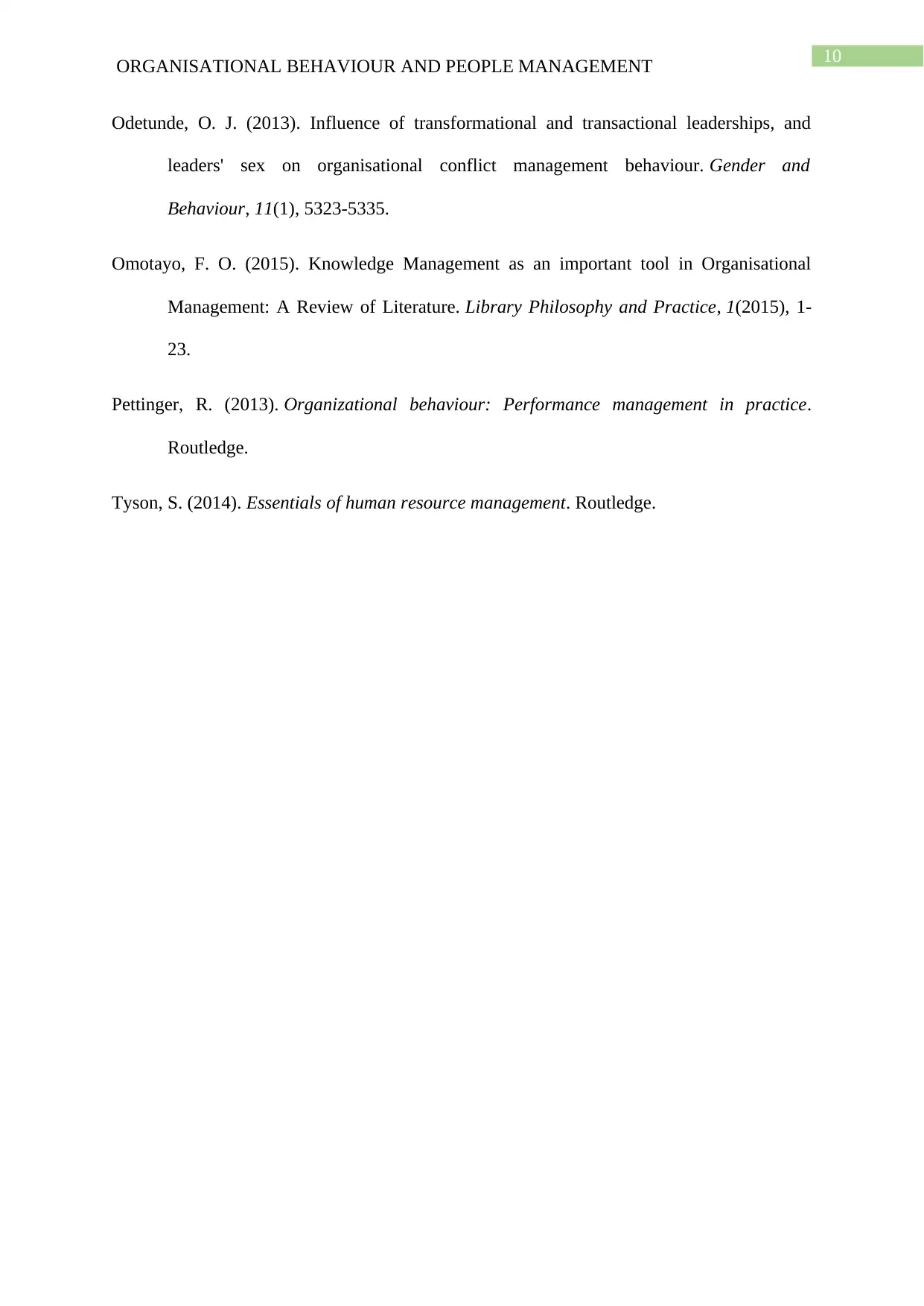
10
ORGANISATIONAL BEHAVIOUR AND PEOPLE MANAGEMENT
Odetunde, O. J. (2013). Influence of transformational and transactional leaderships, and
leaders' sex on organisational conflict management behaviour. Gender and
Behaviour, 11(1), 5323-5335.
Omotayo, F. O. (2015). Knowledge Management as an important tool in Organisational
Management: A Review of Literature. Library Philosophy and Practice, 1(2015), 1-
23.
Pettinger, R. (2013). Organizational behaviour: Performance management in practice.
Routledge.
Tyson, S. (2014). Essentials of human resource management. Routledge.
ORGANISATIONAL BEHAVIOUR AND PEOPLE MANAGEMENT
Odetunde, O. J. (2013). Influence of transformational and transactional leaderships, and
leaders' sex on organisational conflict management behaviour. Gender and
Behaviour, 11(1), 5323-5335.
Omotayo, F. O. (2015). Knowledge Management as an important tool in Organisational
Management: A Review of Literature. Library Philosophy and Practice, 1(2015), 1-
23.
Pettinger, R. (2013). Organizational behaviour: Performance management in practice.
Routledge.
Tyson, S. (2014). Essentials of human resource management. Routledge.
1 out of 11
Related Documents
Your All-in-One AI-Powered Toolkit for Academic Success.
+13062052269
info@desklib.com
Available 24*7 on WhatsApp / Email
![[object Object]](/_next/static/media/star-bottom.7253800d.svg)
Unlock your academic potential
Copyright © 2020–2025 A2Z Services. All Rights Reserved. Developed and managed by ZUCOL.




